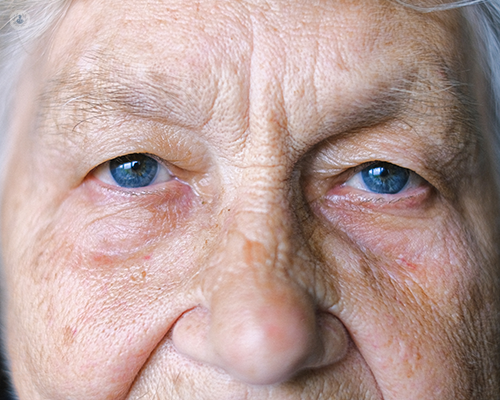Age-related macular degeneration (AMD): Your questions answered
Escrito por:Age-related macular degeneration (AMD) is a common eye disease among people over the age of 50 that affects central vision, causing distorted, blurred or reduced vision.
Here, Mrs Samantha Mann, renowned consultant ophthalmologist, provides an expert insight into AMD. The London-based specialist discusses risk factors, diagnosis, and treatment, among other important points.

How is AMD evaluated and diagnosed?
AMD is evaluated based on the patient’s symptoms. If the patient complains of distortion of vision in one eye or difficulty with reading, an eye examination and then an OCT scan at the back of the eye are normally carried out. To be able to diagnose AMD, there needs to be evidence of disruption of the outer layers of the retina (the central area at the back of the eye that’s used for reading).
AMD is typically divided into wet and dry forms of macular degeneration. It’s especially important to diagnose the wet form, which results in abnormal blood vessels growing into the retina and causing leakage and bleeding, because wet AMD can be treated with injection therapy if it’s detected early enough. Unfortunately, there’s currently no effective treatment for the dry type of macular degeneration.
What factors can predispose the development of AMD?
Patients who have a family history of AMD and patients who smoke are at increased risk.
In addition, many patients develop drusen deposits at the back of their eye, which are small lumps of a waste product that builds up just underneath the retina. These deposits can predispose the eye to developing wet AMD, which then causes increased distortion of vision.
Patients who have drusen deposits are often given an Amsler Grid to monitor their vision. If they notice any change in their vision while checking the Amsler Grid, patients should see their ophthalmologist promptly.
If left untreated, how can AMD affect vision?
If AMD is left untreated, it can result in permanent scarring at the back of the eye and the actual loss of central vision. AMD rarely affects side vision, but it can impact reading and the ability to recognise faces.
What types of treatments are available for AMD?
Anti-VEGF injections are generally used. This is the best treatment for wet AMD, as it can help prevent the abnormal blood vessels from bleeding and leaking at the back of the eye. Currently, ranibizumab, aflibercept, or the newer brolucizumab injection are used, because these are licensed options approved by the National Institute for Health and Care Excellence for use into the back of the eye.
While anti-VEGF injections might sound scary, the injections are actually quite quick and simple to deliver into the back of the eye, with minimal discomfort for the patient. They typically cause a bit of grittiness for about 24 hours, but most patients are able to resume their normal routine the following day.
The downside to anti-VEGF injections is that they have to be given quite regularly. Initially, this is monthly. After, treatment is carried on for at least a few years to achieve the best outcome.
How many anti-VEGF injections can a patient with AMD receive?
Many patients require multiple anti-VEGF injections for several years. Initially, the injections are given monthly. Over time, the frequency is usually reduced to two monthly or three monthly as the fluid and leakage decrease.
The risk of severe infection or any problems following anti-VEGF injections is generally very low.
Can anti-VEGF injections be used in combination with other treatments, such as steroid injections?
Currently, the only drugs licensed to be used for the treatment of wet AMD are anti-VEGF injections such as ranibizumab, aflibercept and brolucizumab.
Steroid injections are only used for other conditions, such as diabetic maculopathy or retinal vein occlusion, when anti-VEGF injections have proven to be ineffective.
Mrs Samantha Mann is a leading consultant ophthalmologist with over 25 years’ experience who specialises in the treatment of medical retina conditions such as AMD.
If you require expert diagnosis and treatment for AMD, don’t hesitate to book an appointment with Mrs Mann via her Top Doctors profile today.



